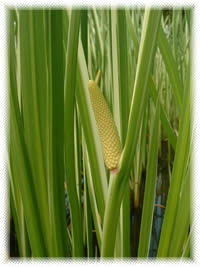Calamus Acorus calamus

chopped calamus root
- Common Names
- Calamus root , Sweet Sledge. Sweet Myrtle, Sweet Flag
- Botanical Name
- Acorus calamus
- Family
- Acoraceae
Medicinal Uses & Benefits of Calamus Root
![]() How to Use|
Side Effects |
Plant & Garden|
Folklore
How to Use|
Side Effects |
Plant & Garden|
Folklore
- Medicinal Uses: * Amenorrhea
* Aphrodisiac
* Asthma
* Ayurvedic
* Colds
* Congestion
* Headache/Migraine
* Sore Throat
* Stop Smoking
- Properties: * Abortifacient * Analgesic * Antibacterial * Antioxidant * Antirheumatic * Aromatic * Bitter * Carminative * Diuretic * emetic * Emmenagogue * Nervine * Psychedelic * Sedative * Uterine Tonic
- Parts Used: Rhizome
- Constituents: cineole,alpha-pinene, alpha-terpineol, azulene, beta-asarone, camphene, camphor, choline, delta-cadinene, elemicin, ethanol, eugenol, galangin , limonene, magnesium , menthol, terpenes, tannin, zinc
How to Use: Calamus
Sweet flag, or calamus has been used since ancient times, however modern misuse of the root oil has given rise to concerns over its use. Traditionally calamus was used for its effects on the digestive system and the lungs. This herb eliminates phlegm, clears congestion, and tranquilizes the mind. Traditional uses include :amnesia, heart palpitations, insomnia, tinnitus, chronic bronchitis, and bronchial asthma.
The root oil is strong and fragrant, its taste warm, bitterish, pungent and aromatic. Its active principles are taken up by boiling water. It is a thick, pale yellow liquid, and has a high toxicity(see cautions.)
In Europe calamus is used as a digestive aid, helping to counter acidity and ease heartburn and dyspepsia. The root is also chewed to help toothache and to help stop smoking. Acorus can blunt gastric upset during the acute phase of drug withdrawal.
Preparation Methods & Dosage :Traditionally taken as a tea, however internal use is not recommended for the casual user. Seek guidance from a herbal practitioner. Calamus may be used externally as a bath additive, or as an alcohol rub for sore muscles and circulation.
Traditional Chinese Medicine
 In TCM sweet flag is used to treat deafness, dizziness and epilepsy. It is used by the Akha people of Thailand for stomachache. The Chinese use it for vomiting, diarrhea, abdominal pain, and dysentery.
2
In TCM sweet flag is used to treat deafness, dizziness and epilepsy. It is used by the Akha people of Thailand for stomachache. The Chinese use it for vomiting, diarrhea, abdominal pain, and dysentery.
2
Ayurvedic Medicine
 Vacha , speaking more clearly, promotes circulation to the brain, sharpens memory, and enhances awareness. 6
Vacha , speaking more clearly, promotes circulation to the brain, sharpens memory, and enhances awareness. 6
Calamus Side Effects: The essential oil of calamus contains aserone, which has a high toxicity. In high doses, it is hallucinogenic. European varieties have a low concentration of aserone compared to those from India. The FDA has issued warnings about the marketing of Aserone contained in Calamus extract as a "Legal Ecstasy", and does not permit the use of calamus in food products. Do not use this herb internally without the supervision of a qualified expert. Use the whole herb only in external applications; never use the essential oil of calamus in extract form. 2,3,4
Plant Description

- Flowers:Spike
- Leaves:Average of 1 cm. The sympodial leaf of Acorus calamus is somewhat shorter than the vegetative leaves. The margin is curly-edged or undulate. The leaves are fragrant and were used as a strewing herb. Botanists distinguish between the Acorus species by the number of prominent leaf veins. Acorus calamus has a single prominent midvein and then on both sides slightly raised secondary veins (with a diameter less than half the midvein) and many, fine tertiary veins. This makes it clearly distinct from Acorus americanus.
- Root: Aromatic, spicy, part used medicinally
- Preferred Habitat:Wetlands
- Distribution:Probably indigenous to India, Acorus calamus is now found across Europe, in southern Russia, northern Asia Minor, southern Siberia, China, Japan, Burma, Sri Lanka, Australia, southern Canada and northern USA.
Regional Traditions :Ayurvedic * European * North America *
History and Traditions & Folklore
Sweet Flag was brought to Europe by the Tartars in the thirteenth century, and is one of the herbs mentioned in the book of Exodus. 2The name 'acorus' is derived from the Greek word 'acoron', a name used by Dioscorides, which in turn was derived from 'coreon', meaning 'pupil', because it was used in herbal medicine as a treatment for inflammation of the eye. 5
The Hebrews used the oil pressed from Acorus, along with oils of olive, cinnamon and myrrh ,in a sacred anointing oil used at the Tabernacle, and used the leaves as a sweet, strewing herb for all places of worship. Acorus leaves are still scattered today on festival days. 1
- Ernst and Johanna Lehner Folklore and Symbolism of Flowers, Plants and Trees (2003).
- Richard Mabey. The New Age Herbalist (1988)
- FDA warnings
- Mountain Rose Herbs
- Grieve, Maud Mrs. "A Modern Herbal" (1931)
- Khalsa, Karta Purkh Singh, Michael Tierra. "The Way of Ayurvedic Herbs", Lotus, (2008)
- Balch, Phyllis A.,CNC. "Prescription for Herbal Healing", (2002)p.67
Acorus is an antioxidant that has special effects on the central nervous system and used to treat a broad range of brain conditions, including stroke.










